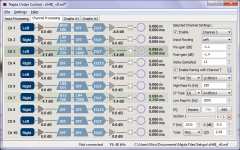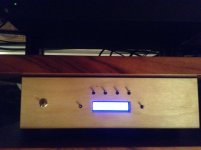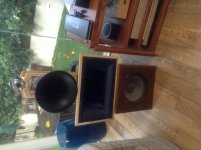What does it mean when the LED for the output processing clip lights up sommetimes,It does so even if I turn the inputgain down to -24db.
If the Output Processing led is lighting on, it means that a block from the Output Processing tab is clipping.
In order to know on what channel this is happening, you can connect the control application NUC and monitor the VU-meters. The upper segment (deep red color) tells you when that channel is clipping.
In other terms, the Output Processing led lights on when at least one of the clipping segments lights on.
Clipping is not related to the absolute value of input gain, but to the combination input/channel gains. If you set -24 dB of input gain, but somewhere +30/36 dB in the Output processing (as seen in your previous setup file), then you will clip.
chaparK, i've sent you an order for Najda DSP (through your site), did you received it?
Because no reply.
thanks
Sorry I was out of office yesterday. Email replied, thank you.
Here's a photo of my Najda. I've now got the hard work of sorting out the filters, but I'm really pleased so far. Thank you so much! (NB: I used the Meanwell 35B power supply - it seems to work well. The 'buttons' are all spring return switches - the up/down and left/right being two way. I've yet to do the IR. The LED is from eb@y - despite the fact that I live in HK, sourcing that was painful!)
Excellent news, it's really great to see your build - and wouldn't mind close-ups! (I actually can't see the leds!).
That's an original front panel you have here. How do you use the switches to navigate through the menu and select/discard items?
The Najda is now playing music through my "big" DIY speakers (Seas T25CF002, prop 6.5" mids and prop 12" woofers) with my three channel LM4780 amps. If it works out I'll build another amp that will be 6 channels in one.
For some reason the IR receiver is not working but I'm sure that's my fault so I'll fixa that later. First I want to adjust the Najda for a rough initial setup. So far I'm just testing with woofers crossed at LR24-80Hz, mids at LR24-80Hz/2500 Hz and highs at LR24-2500 Hz. Sounds pretty good so far.
Excellent stuff Nick!
Excellent news Urban, thanks for letting know all is going fine so far! - well all but the IR.
The pin-out of IR sensors is not standard. As a matter of fact, Vishay has various references that differ only in the pin-out... and this can be confusing. If by any bad luck you have improperly wired the sensor, then chances are it's dead (happened to me...).
Nice to hear that your getting the builds to work.
But one problem here is that the clip warnings don`t turn on instead I get a cracking sound if the digital level seems to high,don`t how yours Nadja does?
Normally, a digital input should not clip, and Najda has no mean to detect a digital input which is out of range. If you have a digital gain on your source, then you can drive it beyond the max (i.e. full-scale). What I mean here is that the audio has clipped before reaching Najda.
If the audio is not clipping at the source level, then it's not clipping either in Najda's receiver; this is a property of digital transmission.
Nice to hear that your getting the builds to work.
But one problem here is that the clip warnings don`t turn on instead I get a cracking sound if the digital level seems to high,don`t how yours Nadja does?
No cracking sound from mine except when playing through my laptop with the PSU connected which is normal and the occasional reminder of SPiKe. I need some more power...
I need some more power...
Have you tried to adjust the nominal output level? The Najda can output up to 6 Vrms so that you can get the most of your power amps - default nominal output is 1 Vrms. See Settings->Board Configuration in NUC.
Have you tried to adjust the nominal output level? The Najda can output up to 6 Vrms so that you can get the most of your power amps - default nominal output is 1 Vrms. See Settings->Board Configuration in NUC.
Yes I have the individual channels set for high output. As much as I would like it I suspect Najda cannot help with clipping power amps
But thanks for your encouragement. I'll still want new amps though
Last edited:
Excellent news, it's really great to see your build - and wouldn't mind close-ups! (I actually can't see the leds!).
That's an original front panel you have here. How do you use the switches to navigate through the menu and select/discard items?
Hi - sorry, I should have been clearer: I was referring to the LED display. I haven't put the LEDs in yet, as I couldn't decide on a pleasing arrangement. The switches are in effect equivalent to push-on switches. The bottom four are just one way (push up is on), while the two at each end of the panel are two way - the left is orientated vertically for volume, while the right is orientated horizontally to scroll left/right through menus. It seems to work OK. Again, I just couldn't find decent push on switches here. As for the front panel, it's 18mm birch ply that I brought back to HK last year for another project, which didn't work out. I don't have the tools to mill the needed square slot in the aluminium panel that came with the case, but I have enough to do small jobs with wood, and to drill holes in aluminium (although despite my best efforts the back panel holes are a mm or so off where I wanted ...).
After a nice hifi-gettogether with friends, Najda was considered the least noisy compared to a Behringer and a dBx unit. Najda will soon have more friends here in Sweden. ;-)
About the pairing, it took me a while to figure out that you actually need to make changes in one channel, for the paired channel to update its settings. It would be far more intuitive if the pairing was automatic, and the paired channel (f.ex. channel 5) was greyed out, meaning that it will mimic the behaviour of channel 1, so no adjustments are possible.
Great work!
About the pairing, it took me a while to figure out that you actually need to make changes in one channel, for the paired channel to update its settings. It would be far more intuitive if the pairing was automatic, and the paired channel (f.ex. channel 5) was greyed out, meaning that it will mimic the behaviour of channel 1, so no adjustments are possible.
Great work!
The switches are in effect equivalent to push-on switches. The bottom four are just one way (push up is on), while the two at each end of the panel are two way - the left is orientated vertically for volume, while the right is orientated horizontally to scroll left/right through menus. It seems to work OK. Again, I just couldn't find decent push on switches here. As for the front panel, it's 18mm birch ply that I brought back to HK last year for another project, which didn't work out. I don't have the tools to mill the needed square slot in the aluminium panel that came with the case, but I have enough to do small jobs with wood, and to drill holes in aluminium (although despite my best efforts the back panel holes are a mm or so off where I wanted ...).
The combination wood panel + old-style switches makes this distinctive 'vintage' look that goes well with the tubes, I like it!
Indeed it's surprising that you couldn't source more parts in HK. I'd have imagined that one can find anything there, with Shenzhen and Guangzhou lying so close. Otherwise you can always find parts on ebay (and many sellers ship from HK
After a nice hifi-gettogether with friends, Najda was considered the least noisy compared to a Behringer and a dBx unit. Najda will soon have more friends here in Sweden. ;-)
Thanks Bo, great to hear that (as much the comparison outcome as the potential new friends in Sweden
About the pairing, it took me a while to figure out that you actually need to make changes in one channel, for the paired channel to update its settings. It would be far more intuitive if the pairing was automatic, and the paired channel (f.ex. channel 5) was greyed out, meaning that it will mimic the behaviour of channel 1, so no adjustments are possible.
I'm looking at improving the visual feedback of the GUI. I might actually pull out a revision where the paired channel is also highlighted (in a slightly different colour than the selected channel).

Sounds great. If you could also transfer the channel settings as soon as the pairing checkbox is ticked, I think we're all good.Thanks Bo, great to hear that (as much the comparison outcome as the potential new friends in Sweden)!
I'm looking at improving the visual feedback of the GUI. I might actually pull out a revision where the paired channel is also highlighted (in a slightly different colour than the selected channel).
View attachment 383050
/Bo
Sounds great. If you could also transfer the channel settings as soon as the pairing checkbox is ticked, I think we're all good.
Alright, I understand now what you meant when you wrote 'automatic' in your previous post
The pairing option is not a copy button. Pairing starts when the option is checked: from this moment everything you change on one channel is replicated on the paired channel. You can anytime uncheck the pairing option and make changes that are proper only to the channel you're working on (then pair again later if you need that).
So it's actually not planned to copy the parameters to the paired channel when the option is checked. If you wish to have 2 channels that are identical in terms of processing parameters, just set the pairing at the start and leave it on all way through. Does this make sense?
Cheers,
Nick
Hi Nick,
slightly off topic, but I am facing a small issue with controlling NAJDA after power off. When I operate NAJDA, all buttons/remote control functions operate correctly. I turn it into stanby by remote and all seems to be OK. If I want to turn it on again next day, nothing works to turn it on (remote and button do not work). I have to turn off the mains switch, turn it on and all works normal. Any idea for an issue? Can it be caused by hanging the ucontroller by operating other remotes for other equipment? Thanks for help.
slightly off topic, but I am facing a small issue with controlling NAJDA after power off. When I operate NAJDA, all buttons/remote control functions operate correctly. I turn it into stanby by remote and all seems to be OK. If I want to turn it on again next day, nothing works to turn it on (remote and button do not work). I have to turn off the mains switch, turn it on and all works normal. Any idea for an issue? Can it be caused by hanging the ucontroller by operating other remotes for other equipment? Thanks for help.
Hi Jiri,
What IR protocol are you using?
Does it also happen if you put Najda in stand by with the push button?
No, Najda either recognizes a IR command or not. If the IR message is unknown, then it's simply ignored.
What IR protocol are you using?
Does it also happen if you put Najda in stand by with the push button?
Hi Nick,
Can it be caused by hanging the ucontroller by operating other remotes for other equipment?
No, Najda either recognizes a IR command or not. If the IR message is unknown, then it's simply ignored.
Hi Nikk and Najda builders 
I've got few questions concerning grounding.
I'm planning to connect the smps ground to the box, there is a connection for this around one mounting hole. What about the ground connector of the power connector ? Should be also connected to the chassis ? In my box the ground of the card is also connected to the chassis via the USB connector that is touching the rear panel. Is all this correct ?
Everything is working fine at the moment but no ground is connected, nor the one of the power connector or the PSU.
I've got few questions concerning grounding.
I'm planning to connect the smps ground to the box, there is a connection for this around one mounting hole. What about the ground connector of the power connector ? Should be also connected to the chassis ? In my box the ground of the card is also connected to the chassis via the USB connector that is touching the rear panel. Is all this correct ?
Everything is working fine at the moment but no ground is connected, nor the one of the power connector or the PSU.
Last edited:
Hi Pascal, these are my recommendations:
1. Connect the earth pin of the power receptacle to the chassis.
2. Connect the earth pin of the power supply (the contact around one mounting hole that you've mentioned) to the chassis.
3. The shield of the USB receptacle is not connected to the board's ground, as far as I can remember. However, I'd recommend no contact between the USB shield and the chassis.
Points 1 and 2 are for your safety. If something goes wrong and a wire conveying the mains makes contact with the chassis, then your protection/earth leakage switch (in French, "disjoncteur differentiel") will kick in. Don't connect Najda's ground to the chassis.
1. Connect the earth pin of the power receptacle to the chassis.
2. Connect the earth pin of the power supply (the contact around one mounting hole that you've mentioned) to the chassis.
3. The shield of the USB receptacle is not connected to the board's ground, as far as I can remember. However, I'd recommend no contact between the USB shield and the chassis.
Points 1 and 2 are for your safety. If something goes wrong and a wire conveying the mains makes contact with the chassis, then your protection/earth leakage switch (in French, "disjoncteur differentiel") will kick in. Don't connect Najda's ground to the chassis.
The addition of an input coupling capacitor will forma high-pass filter with the CS3318’s input impedance.
Given nominal values of input impedance and coupling capacitor, a 10 µFcoupling capacitor will result in
less than 0.03 dB of attenuation at 20 Hz. If additional low-frequency attenuation can be tolerated, a smaller coupling capacitor may be used.
Any one know the input impedance of CS3318,I think I´m going to have to use caps at the input,when I move the volume slider and unmute the filter the DC protection of my sub amp kicks in.
So I wanna calulate the smallest caps possible..
Hi guys,
I have simple question of complicated nature .
.
Is it possible control volume on Najda with rotary encoder or with pot /via ADC/?
If not it is possible to add support for this?
I think many people will appreciate simple volume knob on this nice piece of hardware.
Thanks
Tomas
I have simple question of complicated nature
Is it possible control volume on Najda with rotary encoder or with pot /via ADC/?
If not it is possible to add support for this?
I think many people will appreciate simple volume knob on this nice piece of hardware.
Thanks
Tomas
Any one know the input impedance of CS3318,I think I´m going to have to use caps at the input,when I move the volume slider and unmute the filter the DC protection of my sub amp kicks in.
So I wanna calulate the smallest caps possible..
Hmm, maybe p.8 in the datasheet?
(they say 10 kOhm)
Hi guys,
I have simple question of complicated nature.
Is it possible control volume on Najda with rotary encoder or with pot /via ADC/?
If not it is possible to add support for this?
I think many people will appreciate simple volume knob on this nice piece of hardware.
Thanks
Tomas
Hi Thomas,
No, a volume knob is not supported at the moment. You can currently change the volume the following 3 ways:
- +/- push buttons
- IR remote controller
- volume sliders in the NUC application.
If the volume knob is really required, I could add the feature (encoder).
Best,
Nick
Found it,thanks!Hmm, maybe p.8 in the datasheet?
(they say 10 kOhm)
If the volume knob is really required, I could add the feature (encoder).
It would be GREAT
- Home
- Source & Line
- Digital Line Level
- DSP Xover project (part 2)

